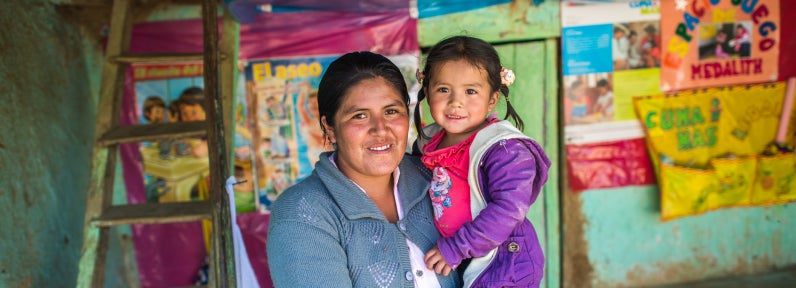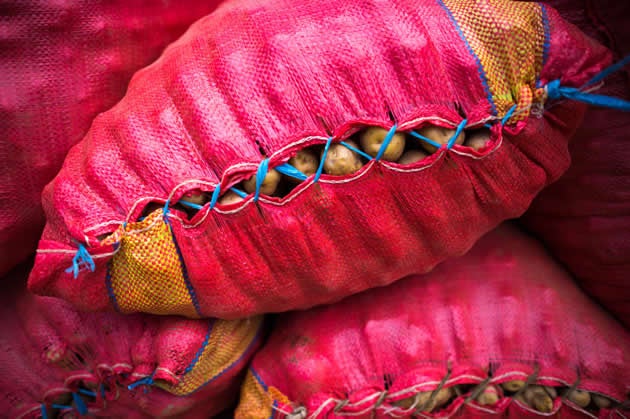Key Points
Childhood stunting prevalence in Peru declined by 55 percent in eight years—from 28 percent in 2008 to 13 percent in 2016. Economic growth contributed to this decline but was not the primary driver.
While stunting reduction was not uniform across the country, equity largely improved as stunting prevalence fell: rural areas (47 to 26 percent from 2008 to 2016) and lower wealth quintiles (54 to 30 percent for the poorest quintile) experienced some of the greatest improvements.
Peru’s government and civil society organizations collaborated to develop a deliberate, multi-sectoral strategy to reduce stunting that spanned across levels of government. The evidence-based and targeted nature of interventions made them particularly effective.

A 50 percent reduction in just eight years
From 2008 to 2016, the rate of childhood stunting in Peru fell from 28.2 percent to 13.1 percent—bringing the number of stunted children from approximately 775,000 to just over 380,000. Even discounting the effects of Peru’s high economic growth rate during this period, the scale of decline of stunting in Peru—a 55 percent decrease in eight years—is noteworthy.
Stunting is often viewed as an expression of GDP, with lower income countries generally reporting higher rates of stunting. Peru’s experience demonstrates that GDP does not fully determine stunting rates. Our analysis indicates that economic growth likely contributed to Peru’s stunting reduction, but that other factors were far more important. The muted impact of GDP on stunting is supported by a wealth of evidence, including data from the 2000 to 2005 period when Peru’s GDP growth rate climbed from 2.7 percent to 6.3 percent. During this period of robust growth, the country’s stunting rate fell a single percentage point, from 31 to 30 percent, with Peru continuing to record one of the highest levels of stunting in Latin America. Though our analysis of the relationship between stunting and GDP does not preclude the possibility that there is a longer than expected lag between economic growth and stunting, our evidence points to other powerful drivers of stunting reduction.
Stunting rates began their remarkably steep decline only in 2008, after Peru prioritized a targeted, evidence-based strategy which included a mix of established and new programs to:
- Provide the poor with free health insurance.
- Provide conditional cash transfers to reduce extreme poverty and support health-seeking behavior among poor, indigenous, rural families.
- Improve the quality and frequency of preventive health care, including family planning, for women and provide nutrition and hygiene education for expecting and new mothers in poor, rural areas.
- Improve the quality and frequency of preventive health care for children in their first 1,000 days in poor, rural areas.
The stunting reduction that followed, while not uniform across the country, was significant in all states and economic groups. From 2008 to 2016, stunting declined from 47 to 26 percent in rural areas; from 18 to 8 percent in urban areas; from 54 to 30 percent among the lowest wealth quintile; and from 42 to 13 percent among the second lowest wealth quintile. That stunting fell sharply even in poor, rural communities - Peru’s most disenfranchised - is an indication that the country’s targeted stunting reduction programs were effective.
What can we learn from Peru?
While other countries often approach stunting reduction by narrowly focusing on nutrition-specific programs, Peru took an entirely different approach. It focused on improving health care and incentivizing access to quality services including antenatal care, preventive care, and immunizations. By empowering communities to access quality health services and reducing inequalities, reducing poverty and food insecurity, Peru reached a tipping point and made historic gains against stunting. It is worth noting that Peru accomplished this on a tight budget: the country spends only about five percent of its budget on health, significantly below the Latin American average of almost eight percent.
Our research, using quantitative and qualitative analysis, as well as an extensive literature review, explores this multi-sectoral success story with the goal of identifying best practices and sharing lessons learned. While we have not isolated a silver bullet responsible for all of Peru’s progress, we have identified factors critical to the success of Peru’s strategy :
- Highly targeted, evidence-based health and nutrition programs.
- Incentives to motivate poor families and government officials.
- Rigorous and continuous monitoring.
- Programs to increase demand, supply, and quality of preventive health care, including family planning.
These factors enabled the successful implementation of Peru’s strategy to establish a culture of health-seeking in rural Peru that would improve health broadly, and significantly reduce stunting.

